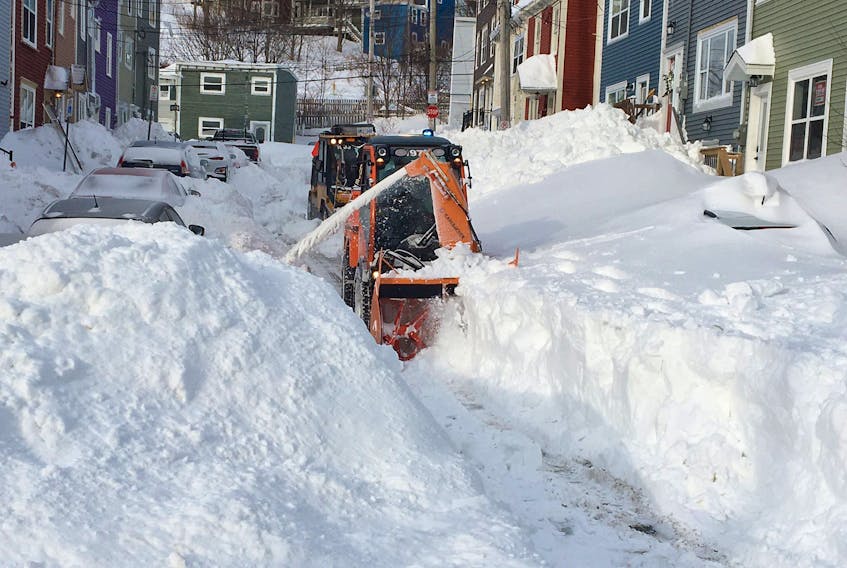The winter of 2019-2020 has officially given way to spring.
This is the time when Atlantic Canadians start chewing the fat over how the winter was, and what that might portend for spring. Climate change is now an inevitable part of that conversation, as we try to figure out what it all means for the future.
Unfortunately, the weather doesn’t care about narratives, plans, analyses or models. The weather simply is, and it is left to us to connect the dots. We’ve gotten very good at identifying these trends, mapping them out over time and building models based on observation.
But there’s a catch.

As a veteran weather observer, SaltWire chief meteorologist Cindy Day knows no single day, season, or year can tell us where trends are headed. Each storm or season is like a goaltender who allows eight goals in one game, and none the next. On average, he’s been scored on four times a game, but that average tells you nothing about how poorly he played in game one versus how well he played in game two. Over a whole season, or a whole career, however, that data becomes indicative of the true trend.
So, how we can talk about global warming when we can vividly remember that January storm dropping 76 centimetres of snow on Newfoundland?
“To form a climate opinion, you really need ten years of data to look for a trend. One winter won’t do it, you have to step back and do a decade,” says Day.
“But within that trend, things happen because of climate change, and that storm in Newfoundland is a good example of that. That storm had energy almost like a hurricane. In fact, the sustained winds were category 2 hurricane force. That was like a winter hurricane.”
Jet stream impact
Day explains that the scaffolding of any winter’s weather is built on two foundations. One is the stationary weather patterns that control and steer the jet stream. One such system, the Bermuda/Azores High, is a semi-permanent zone of high-pressure air in the Atlantic. The northern polar jet stream is a tightly-contained stream of air that flows west to east at an altitude of nine to 12 kilometres.
“I like to refer to the jet stream as an imaginary highway in the upper levels of the atmosphere, and storm systems track along the jet stream,” says Day.
“So if that jet stream is right overhead, you will be under the center of the storm, areas south of that jet stream will be on the warmer side of that system because the system will pull in a south-westerly flow of warmer air. The Bermuda/Azores High is one of these controlling systems that steers the jet stream, and it will either push it up over Atlantic Canada or let it sag down.”

From mid-fall until now, the jet stream has been draped across northern New Brunswick, just across Prince Edward Island and up through southwestern Newfoundland across to its east coast. As systems have tracked this stream, they’ve dumped snow on those areas.
“The winter weather was a result of the position of the Bermuda High that, in turn, steered the jet stream to a location that brought the systems through and that’s where the heaviest snow sat,” says Day.
“South of that we did get some weather events, but nothing terribly significant because of the milder temperatures.”
To return to the epic storm in Newfoundland, how can it be possible that warming temperatures lead to an influx of snow? It all has to do with the way storms gather and dissipate energy.
“The sea surface temperatures off the coast were one-and-a-half to two degrees above average. Doesn’t sound like a lot in terms of a temperature, but for a sea-surface temperature, that’s huge,” says Day.
“So that energy fueled into the cold air above, and that just was explosive. We called it a weather bomb, and that has a true definition. People don’t like that expression, but it’s a very rapid drop in central pressure of a system.”
Look ahead at spring

As we move into spring, the same underlying structures, the high and the jet stream, will determine what the day-to-day weather ends up looking like. The jet stream itself is tracking north, but will slowly transition south of Atlantic Canada as summer comes. The current position of the high, plus the angle of the jet stream, are telling Day that this is going to be a slow transition.
“So a cool spring, an unsettled spring, until we get to nicer weather. I hate to say it, but pretty typical Maritime spring, a very slow transition,” says Day. “Not one of our faster, better transitions to spring.”
The climate impacts in our spring and summer can be less dramatic as measured by precipitation events, hurricanes and tropical storms notwithstanding. A few degrees warmer in February, and you get rain instead of snow. A few degrees warmer in June, and you still get rain.
“I often think about that when I'm working really hard on a rainstorm in June,” says Day.
“I think, ‘If this was winter, people would be all over it and they’d be excited about it.’ Whether I get 15 millimetres of rain from my storm or 40, most people don’t notice the difference. But 15 centimetres of snow to 40 centimetres of snow is a whole different ball of wax.”
Day says people can expect a trend towards longer dry periods in spring and summer punctuated by more intense storms. On average, precipitation will remain similar, but the way it’s distributed could be a problem.
“Just like the storms are going to be more intense, the dry periods will be, too. And we’ve noticed over the past couple of decades, very serious drought conditions in western regions of Nova Scotia. some serious drought through parts of New Brunswick as well,” says Day.
“We have lengthier periods with no precipitation. Meanwhile, once the developing storm behind that kicks through, it’s more powerful with intense rain bands. We’re looking at a greater rate of rainfall and potential flooding. And with those more powerful winds, because those storms are intensifying over time, we’re looking at more coastal erosion and localized flooding.”
Addressing climate change
Heading into spring, we want to hear about warmer weather and better times. But the weather doesn’t respond to what we want or wish.
Day believes that the best thing to do is what we’ve always done: talk and come up with a plan to deal with the situation at hand. The steps we take to work through spring 2020 are the steps that will help carry us into the coming years as we attempt to mitigate the overall climate trend at the same time as we deal with the day’s weather.
“We just need to have this conversation. Everybody has to talk about it, and the more we talk about it and the more we expand that group, our little circle of people that we talk about, climate change and weather, i think it’s a good thing,” says Day.
“All the little things that we do, bringing that reusable bag to the grocery store, walking instead of taking the car when you're only going a short distance. Turning off lights. Not using plastics and cutlery and, when you go to the Tim Horton’s, bring your thermal cup with you. All those little things, they do add up.”









